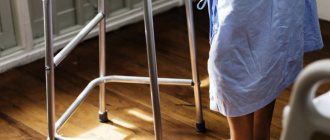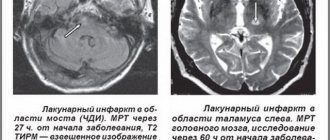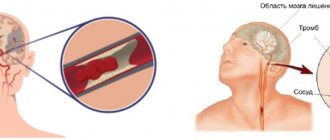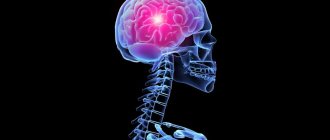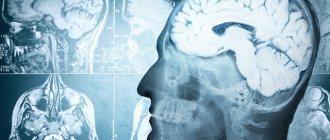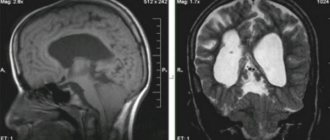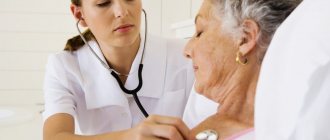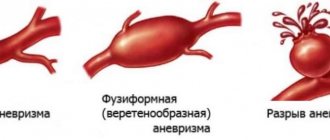Stroke is a serious nervous disease due to disturbances in the vital functions of the brain. Depending on the location of the lesion, patients may experience different symptoms. There are hemorrhagic stroke (rupture of blood vessels in the cerebral cortex, hemorrhage) and ischemic stroke (the left side of the human brain is affected due to blockage of blood vessels by blood clots or plaques). Doctors name the following causes of stroke as the most likely:
- Diseases of the cardiovascular system;
- Blood composition disorders;
- Some infectious diseases;
- Diabetes;
- Abuse of hormonal and contraceptive drugs;
- Frequent migraines accompanied by aura;
- Osteochondrosis of the cervical spine;
- Bad habits (smoking, alcohol)
Symptoms and signs of left-sided ischemic stroke
Left-sided stroke has general and specific symptoms. General symptoms include severe and sharp headache, vomiting, impaired consciousness, impaired coordination of movements, speech, and vision. The rhythm of breathing may change, and difficulty swallowing may occur. Symptoms may vary depending on the location of the lesion in the brain.
A feature of a stroke that affects the left hemisphere of a person’s brain is complete or partial paralysis of the right side of the body. Sensitivity is impaired and muscle tone changes. In the cortex of the left hemisphere there are areas responsible for speech functions (Wernicke's center and Broca's center). With severe damage to these areas, patients completely lose the ability to speak. In mild cases, they can only speak individual words.
Often, with a left-sided stroke, patients’ ability to think logically disappears and lethargy occurs. If the lesion is located in the temporal lobe of the left hemisphere, then the patient’s emotional state is disturbed. Depression occurs, which, in combination with speech impairment, significantly complicates the correct diagnosis.
Treatment of brainstem stroke
The main therapy is aimed at eliminating the cause of the lesion - a blood clot or hemorrhage. Hematomas are removed surgically. If blood clots form, therapy is used to dissolve and prevent their formation. Drugs that thin the blood, regulate cholesterol levels, and control heart rate are administered. If respiratory function is lost, a special tube is inserted into the person's trachea to provide oxygen.
In most cases, a brainstem stroke leads to death, since most of the vital functions of the human body stop working. In order to avoid such a serious disease as a brainstem stroke, it is important to be regularly examined by doctors if you have other diseases of the cardiovascular system. It is also necessary to give up bad habits, lead a healthy lifestyle, and eliminate stressful situations from your life as much as possible.
Therapy after ischemic stroke of the left side
The most important factor influencing a positive treatment outcome is efficiency. A quick and correct diagnosis will help you correctly draw up a step-by-step and comprehensive treatment plan. It is important to remember that there is a so-called “therapeutic window” when the process of neuronal changes is still reversible. This usually occurs within a period of 3 to 6 hours from the moment of injury. It is at this time that it is necessary to quickly hospitalize the patient for intensive care or surgery. After emergency assistance is provided, a plan is developed for the subsequent rehabilitation period. Speech therapists and psychologists work with patients who have suffered a left-sided stroke. They are prescribed the following procedures to stimulate the compensatory functions of brain neurons (neuroplasticity):
- Physiotherapy;
- Massage;
- Electrical stimulation;
- Kinesitherapy.
What is the brain stem
The human brain stem is a special organ that connects the brain and nervous system with the rest of the organs of our body. This is where the signals that make our heart beat, lungs breathe, and arms and legs move occur.
There is not a single system in our body that does not depend on the brain stem. The trunk is located deep in the skull under the hemispheres. If the blood circulation is impaired, a tumor immediately occurs here, the trunk moves and is pinched, which leads to disability or death of the patient.
The trunk is usually divided into three parts. The first is the medulla oblongata. It is responsible for breathing, heart rate, coughing, sneezing, blinking and swallowing. Functional disorders of the medulla oblongata can lead to cardiac or respiratory arrest, which is dangerously fatal.
The second part of the brainstem is the pons. The connection between the brain and the spinal cord and cerebellum passes through this bridge. It is through this bridge that all auditory information passes. The ternary, facial, statoacoustic and abducens nerves begin in this section.
Violations of this part of the trunk are fraught with deafness, facial paralysis and other complications.
The third part of the trunk is the midbrain. This part of the trunk is responsible for body movement, unconscious movements. Violations in this part of the trunk lead to limited movement.
Possible consequences
Sagging muscles on the right side of the body, slurred speech or its complete absence, convulsive twitching and difficulties in articulation, difficulties or partial memory loss, difficulties in analyzing the situation, difficulty in perceiving any new information, inadequate perception of what is heard, a depressive state - all this is felt by people, survivors of left-sided ischemic stroke. Not all of the consequences are listed. Despite the fact that the process of treatment and recovery after a stroke is always long and tedious, there is a chance to regain your previous abilities. The main thing is to provide timely assistance to the victim.
Causes of pathology
Brainstem stroke occurs due to bleeding in the brainstem or blockage of blood flow. With increased load on the vessels of the brain stem, their walls become thinner and weaken. A vessel rupture can occur at any moment, and then a brainstem stroke is inevitable.
There are several reasons why blood vessels can become weak and brittle, among them the most common:
- Atherosclerosis.
- Diabetes.
- Hypertension 2,3,4 degrees.
- Rheumatic vasculitis.
- Hereditary predisposition.
- Excess weight.
In addition, the risk of stroke increases if you have bad habits. Alcohol and smoking have a detrimental effect on the condition of the vascular wall, causing its fragility and fragility. Also at risk are elderly patients, whose vessel walls change due to old age. Doctors advise women in climatic periods to pay special attention to their health. The first warning sign of a stroke is high blood pressure.
Signs
A vascular accident does not occur asymptomatically; it is preceded by cerebrovascular accidents. A stroke often occurs while sleeping or upon awakening. Drinking alcohol and taking a hot bath can also trigger cerebral vasospasm. The development of ischemic stroke of the right hemisphere as a result of thromboembolism is characterized by pronounced symptoms.
In patients admitted to the neurology clinic of the Yusupov Hospital, the following symptoms of the disease are revealed during diagnosis:
- partial or complete paralysis of the left side of the body;
- disturbances in sensation and perception of one’s own body and objects;
- loss of memory about current events, while patients remember past events;
- ignoring the left visual field;
- left-handers experience speech disorders;
- inability to concentrate;
- disorders of the emotional-volitional sphere of personality;
- depressive states;
- unbalanced behavior;
- changes in the face, in which the corner of the mouth droops, the nasolabial fold on the right side is smoothed out.
Ischemic stroke of the right hemisphere is characterized by the predominance of general cerebral signs of disturbance over focal ones at the beginning of the attack. Treatment of ischemic stroke at the Yusupov Hospital is carried out using innovative techniques that significantly increase the likelihood of restoration of lost functions and the chances of recovery.
Rehabilitation
The patient’s rehabilitation plan must be developed individually by the attending physician. Rehabilitation is needed primarily to alleviate the symptoms of the disease and improve the patient’s quality of life. For speech disorders, classes with a speech therapist are recommended; patients with swallowing problems need to learn special techniques to learn how to swallow soft food; those with paralysis of the limbs are prescribed special massages and exercises.
For effective rehabilitation, the participation of the patient's relatives is very important. Close people can provide invaluable assistance in restoring the patient’s health. The patient needs constant care, support and understanding.
If relatives strictly follow all the doctor’s recommendations, the chances of partial or complete recovery greatly increase.
Often, even small progress takes quite a long time. If you are faced with such a disease in your family, the main thing is not to give up. For example, the motor ability of the limbs is restored within a year, while other disorders can take even longer to be treated. Most often, a person will never be able to return to a full life, but there is a chance that he will be able to take care of himself.
Stroke in old age
How long do older people live after a stroke? In older people, the disease can occur for the following reasons:
- hypertension;
- kidney disease;
- problems with the endocrine system;
- diabetes;
- vascular aneurysms;
- atrial fibrillation;
- rheumatism;
- high cholesterol;
- sedentary lifestyle;
- any viral disease in severe form.
The most common cause of stroke in older people is atherosclerosis, which can provoke a large number of attacks per year, and they may go completely unnoticed by the person. If this process continues for a long time, it is impossible to survive - death occurs.
How long a person lives after a stroke in old age is a complex question. According to statistics, the forecasts are as follows:
- With extensive hemorrhage that occurred in the brain center - death.
- With atherosclerosis and hypertension, survival is possible in rare cases, and the consequences will be very severe.
- With cerebral edema, the prognosis is also poor.
- In case of relapse - death.
The average life expectancy after a stroke that occurs after age 80 is a week. It turns out that the older you are, the less likely you are not only for recovery, but also for survival in general.
Features of therapy
Complex therapy for right-sided stroke is divided into correction of the acute period and rehabilitation. During the acute period, if there is a risk of severe consequences, surgical intervention may be required. The patient remains in the intensive care unit throughout the acute period. Treatment of right-sided stroke of any origin is carried out in several areas:
- basic: for ischemia - thrombolytics, disaggregants, anticoagulants (thrombolysis with a recombined type plasminogen activator is most effective), for hemorrhage - emergency hemostatic and vasoconstrictor agents;
- hypotensive: drugs that lower blood pressure relieve compression of nerves, remove tissue pastiness (Betalok, Stugeron, Triampur);
- normalizing cerebral blood flow: drugs with vasoactive and antiplatelet properties (Trental, Cavinton, Eufillin);
- neuroprotective: restore connections between neurons (Cellex);
- antioxidant: detoxify tissues, remove free radicals, renew cells (Vitamin E, C, Lycopene).
In the acute phase, it is important to control breathing, heart rate, and body temperature. Treatment is most effective during the first three, maximum five hours after the attack. Within a day, irreversible processes occur in neurons.
